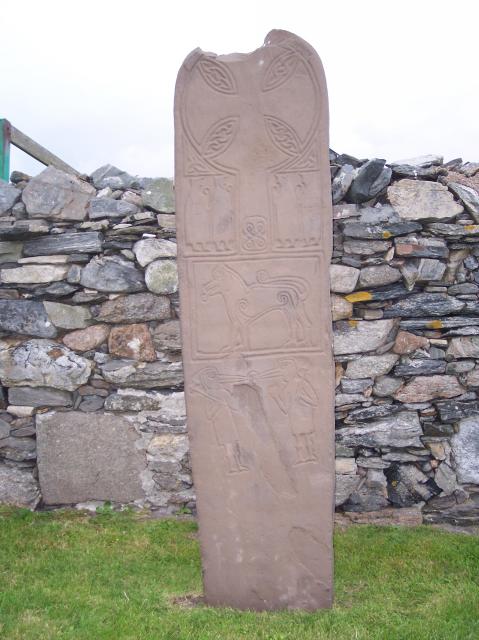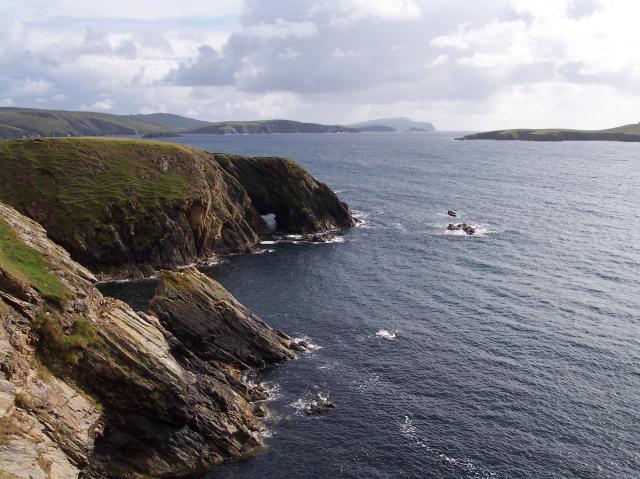|
Trondra
Trondra ( sco, Trondra) is one of the Scalloway Islands, a subgroup of the Shetland Islands in Scotland. It shelters the harbour of Scalloway and has an area of . History Trondra was becoming rapidly depopulated until 1970, when road bridges were built to neighbouring Burra (West and East) and to the southern peninsula of the Shetland Mainland. Since then the population has recovered from a low of 20 in 1961. A local community hall was opened in 1986. Composition Settlements on the island include: *Burland - Burland houses one of Shetland's most popular tourist attractions - the Burland Croft Trail. * Cauldhame * Cutts *Glendale * Scarfataing Geology Trondra is made up of steeply inclined dalradian rocks; mainly quartz and mica rich schists but with some crystalline limestone in the north which provide fertile soils around Cauldhame and Cutts. The hills are covered in grass and heather, with trees being few and far between, much like the rest of the Shetland Islands. Wildl ... [...More Info...] [...Related Items...] OR: [Wikipedia] [Google] [Baidu] |
Cutts, Shetland
Cutts is a settlement in the Shetland Islands, United Kingdom. It is on the island of Trondra off the west coast of Shetland Mainland. The B9074 crosses the Trondra Bridge at the north-east of Cutts. The bridge, opened on 18 October 1971 by George Younger George Kenneth Hotson Younger, 4th Viscount Younger of Leckie, Baron Younger of Prestwick, (22 September 1931 – 26 January 2003), was a British Conservative Party politician and banker. Early life and career Younger's forebear, George Younge ..., has a single carriageway and connects Trondra with Shetland Mainland. References External linksCanmore - Trondra, The Cutts site record Villages in Shetland {{Shetland-geo-stub ... [...More Info...] [...Related Items...] OR: [Wikipedia] [Google] [Baidu] |
Shetland Islands
Shetland, also called the Shetland Islands and formerly Zetland, is a subarctic archipelago in Scotland lying between Orkney, the Faroe Islands and Norway. It is the northernmost region of the United Kingdom. The islands lie about to the northeast of Orkney, from mainland Scotland and west of Norway. They form part of the border between the Atlantic Ocean to the west and the North Sea to the east. Their total area is ,Shetland Islands Council (2012) p. 4 and the population totalled 22,920 in 2019. The islands comprise the Shetland constituency of the Scottish Parliament. The local authority, the Shetland Islands Council, is one of the 32 council areas of Scotland. The islands' administrative centre and only burgh is Lerwick, which has been the capital of Shetland since 1708, before which time the capital was Scalloway. The archipelago has an oceanic climate, complex geology, rugged coastline, and many low, rolling hills. The largest island, known as " the Mainland", ha ... [...More Info...] [...Related Items...] OR: [Wikipedia] [Google] [Baidu] |
Shetland
Shetland, also called the Shetland Islands and formerly Zetland, is a subarctic archipelago in Scotland lying between Orkney, the Faroe Islands and Norway. It is the northernmost region of the United Kingdom. The islands lie about to the northeast of Orkney, from mainland Scotland and west of Norway. They form part of the border between the Atlantic Ocean to the west and the North Sea to the east. Their total area is ,Shetland Islands Council (2012) p. 4 and the population totalled 22,920 in 2019. The islands comprise the Shetland (Scottish Parliament constituency), Shetland constituency of the Scottish Parliament. The local authority, the Shetland Islands Council, is one of the 32 council areas of Scotland. The islands' administrative centre and only burgh is Lerwick, which has been the capital of Shetland since 1708, before which time the capital was Scalloway. The archipelago has an oceanic climate, complex geology, rugged coastline, and many low, rolling hills. The lar ... [...More Info...] [...Related Items...] OR: [Wikipedia] [Google] [Baidu] |
Scalloway Islands
The Scalloway Islands are in Shetland opposite Scalloway on south west of the Mainland. They form a mini-archipelago and include: * Burra (two islands linked by bridge to each other and Trondra) ** East Burra (with Houss Ness) ** West Burra ** South Havra ** Little Havra ** Papa – belongs to Civil parish of Lerwick ** West Head of Papa (tidal) The aforementioned islands were all part of the ancient civil parish of Burra, which was merged with Lerwick in 1891. They are shown on coloured maps as part of Lerwick. Retrieved June 18, 2017 * /Hildesay – belongs to Civil parish of Tingwall * Langa ... [...More Info...] [...Related Items...] OR: [Wikipedia] [Google] [Baidu] |
Burra, Shetland
Burra (Old Norse: ''Barrey'' ) is the collective name for two of the Shetland Islands, West (pop. 753) and East Burra (pop. 66), which are connected by bridge to one another, and to the Shetland Mainland via Trondra. In addition, Burra was an ancient Civil parish that included smaller additional islands such as South Havra, Little Havra, Papa and the tidal island West Head of Papa. The civil parish of Burra was merged into the civil parish of Lerwick, along with Quarff and Gulberwick, in 1891. It continues to exist as Quoad sacra parish of the Church of Scotland. ''Collins Encyclopedia of Scotland'' suggests that the name is a corruption of "Borgarey" (island of the broch),Keay, J. & Keay, J. (1994) ''Collins Encyclopaedia of Scotland''. London. HarperCollins. and while this is unlikely, and no broch is extant, the place name Brough, on West Burra West Burra is one of the Scalloway Islands, a subgroup of the Shetland Islands in Scotland. It is connected by bridge to ... [...More Info...] [...Related Items...] OR: [Wikipedia] [Google] [Baidu] |
West Burra
West Burra is one of the Scalloway Islands, a subgroup of the Shetland Islands in Scotland. It is connected by bridge to East Burra. With an area of , it is the eleventh-largest of the Shetland Islands. Geography The nearby south-facing sandy beach at Meal is a popular place on a warm day. At the south end of West Burra is Kettla Ness, with impressive cliff scenery; it is linked to the main island by a shingle and sand tombolo which also provides another attractive sandy beach. At Duncansclett, a traditional thatched cottage has recently been restored for use by the local history group; the building featured in the BBC television series, 'Restoration'. West Burra is linked to the Shetland Mainland via Trondra by a series of bridges. Settlements Hamnavoe (an extremely common Shetland name) is the main settlement, and there is also Bridge End, so called because it is near the bridge to East Burra. History ''Collins Encyclopedia of Scotland'' suggests that the name " Bu ... [...More Info...] [...Related Items...] OR: [Wikipedia] [Google] [Baidu] |
East Burra
East Burra ( sco, East Burra; Old Norse: "Barrey"Anderson, Joseph (Ed.) (1893) ''Orkneyinga Saga''. Translated by Jón A. Hjaltalin & Gilbert Goudie. Edinburgh. James Thin and Mercat Press (1990 reprint). ) is one of the Scalloway Islands, a subgroup of the Shetland Islands in Scotland. It is connected by a bridge to West Burra. With an area of it is the twelfth largest of the Shetland Islands. East Burra has a much smaller population than West Burra and no substantial settlement; rather, there are a few hamlets and a scattering of individual croft houses. It is known for its Neolithic remains including a burnt mound, and for sea caves. The roofless, plain, Old Haa (manor or laird's house) of Houss is a prominent feature. From Houss, it is possible to walk the two kilometres or so to the cliffs at the southern end of the island. From there, the island of South Havra, nowadays home only to sheep and seabirds, can be clearly seen. East Burra is linked to the Shetland Mainl ... [...More Info...] [...Related Items...] OR: [Wikipedia] [Google] [Baidu] |
Mainland, Shetland
The Mainland is the main island of Shetland, Scotland. The island contains Shetland's only burgh, Lerwick, and is the centre of Shetland's ferry and air connections. Geography It has an area of , making it the third-largest Scottish island and the fifth largest of the British Isles after Great Britain, Ireland, Lewis and Harris and Skye. Mainland is the second most populous of the Scottish islands (only surpassed by Lewis and Harris), and had 18,765 residents in 2011 compared to 17,550 in 2001. The mainland can be broadly divided into four sections: *The long southern peninsula, south of Lerwick, has a mixture of moorland and farmland and contains many important archaeological sites. **Bigton, Cunningsburgh, Sandwick, Scalloway, and Sumburgh *The Central Mainland has more farmland and some woodland plantations. *The West Mainland **Aith, Walls, and Sandness *The North Mainland – in particular the large Northmavine peninsula, connected to Mainland by a narrow isthmus at ... [...More Info...] [...Related Items...] OR: [Wikipedia] [Google] [Baidu] |
Rutabaga
Rutabaga (; North American English) or swede (British English and some Commonwealth English) is a root vegetable, a form of ''Brassica napus'' (which also includes rapeseed). Other names include Swedish turnip, neep (Scots), and turnip (Scottish and Canadian English, Irish English and Manx English). However, elsewhere the name "turnip" usually refers to the related white turnip. The species ''Brassica napus'' originated as a hybrid between the cabbage (''Brassica oleracea'') and the turnip (''Brassica rapa''). Rutabaga roots are eaten as human food in various ways, and the leaves can be eaten as a leaf vegetable. The roots and tops are also used for livestock, either fed directly in the winter or foraged in the field during the other seasons. Scotland, Northern and Western England, Wales, the Isle of Man and Ireland had a tradition of carving the roots into lanterns at Halloween. Etymology Rutabaga has many national and regional names. ''Rutabaga'' is the common North Am ... [...More Info...] [...Related Items...] OR: [Wikipedia] [Google] [Baidu] |
Black Guillemot
The black guillemot or tystie (''Cepphus grylle'') is a medium-sized seabird of the Alcidae family, native throughout northern Atlantic coasts and eastern North American coasts. It is resident in much of its range, but large populations from the high arctic migrate southwards in winter. The bird can be seen in and around its breeding habitat of rocky shores, cliffs and islands in single or smalls groups of pairs. They feed mainly by diving towards the sea floor feeding on fish, crustaceans or other benthic invertebrates. They are listed on the IUCN red list as a species of least concern. Both sexes have very similar appearances with black plumage and a large white patch on the upper side of their wings in summer. The bill is also black, being rather long and slender, while the feet are coral-red. In winter adult underparts are white and the upperparts are a pale grey with the back and shoulders exhibiting barred light grey and white patterning. The birds breed in solitary pairs o ... [...More Info...] [...Related Items...] OR: [Wikipedia] [Google] [Baidu] |
Gull
Gulls, or colloquially seagulls, are seabirds of the family Laridae in the suborder Lari. They are most closely related to the terns and skimmers and only distantly related to auks, and even more distantly to waders. Until the 21st century, most gulls were placed in the genus ''Larus'', but that arrangement is now considered polyphyletic, leading to the resurrection of several genera. An older name for gulls is mews, which is cognate with German ''Möwe'', Danish ''måge'', Swedish ''mås'', Dutch ''meeuw'', Norwegian ''måke''/''måse'' and French ''mouette'', and can still be found in certain regional dialects. Gulls are typically medium to large in size, usually grey or white, often with black markings on the head or wings. They typically have harsh wailing or squawking calls; stout, longish bills; and webbed feet. Most gulls are ground-nesting carnivores which take live food or scavenge opportunistically, particularly the ''Larus'' species. Live food often includes crustac ... [...More Info...] [...Related Items...] OR: [Wikipedia] [Google] [Baidu] |






